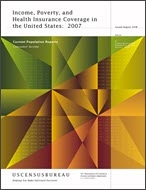Income, Poverty, and Health Insurance Coverage in the United States: 2007
Income, Poverty, and Health Insurance Coverage in the United States: 2007
Introduction
This report presents data on income, poverty, and health insurance coverage in the United States based on information collected in the 2008 and earlier Annual Social and Economic Supplements (ASEC) to the Current Population Survey (CPS) conducted by the U.S. Census Bureau.
Data presented in this report indicate the following:
- Real median household income increased between 2006 and 2007—the third annual increase.1
- The poverty rate was not statistically different between 2006 and 2007.
- Both the number and the percentage of people without health insurance coverage decreased between 2006 and 2007.
These results were not uniform across groups. For example, between 2006 and 2007, real median household income rose for non-Hispanic Whites and Blacks but remained statistically unchanged for Asians and Hispanics; the poverty rate increased for children under 18 years old but remained statistically unchanged for people 18 to 64 years old and people 65 and over; and the percentage of people without health insurance decreased for the native-born population, while the foreign-born population remained statistically unchanged.2,3
These results are discussed in more detail in the three main sections of this report—income, poverty, and health insurance coverage. Each section presents estimates by characteristics such as race, Hispanic origin, nativity, and region. Other topics include earnings of year-round, full-time workers; families in poverty; and health insurance coverage of children. This report concludes with a section discussing health insurance coverage by state using 2- and 3-year averages.
__________
1 All income values are adjusted to reflect 2007 dollars. “Real” refers to income after adjusting for inflation. The adjustment is based on percentage changes in prices between earlier years and 2007 and is computed by dividing the annual average Consumer Price Index Research Series (CPI-U-RS) for 2007 by the annual average for earlier years. The CPI-U-RS values for 1947 to 2007 are available in Appendix A and on the Internet at <www.census.gov/hhes/www/income/income07/AA-CPI-U-RS.pdf>. Inflation between 2006 and 2007 was 2.8 percent.
2 Federal surveys now give respondents the option of reporting more than one race. Therefore, two basic ways of defining a race group are possible. A group such as Asian may be defined as those who reported Asian and no other race (the race-alone or single-race concept) or as those who reported Asian regardless of whether they also reported another race (the race-alone-or-in-combination concept). The body of this report (text, figures, and text tables) shows data using the first approach (race alone). The appendix tables show data using both approaches. Use of the single-race population does not imply that it is the preferred method of presenting or analyzing data. The Census Bureau uses a variety of approaches.
In this report, the term “non-Hispanic White” refers to people who are not Hispanic and who reported White and no other race. The Census Bureau uses non-Hispanic Whites as the comparison group for other race groups and Hispanics.
Because Hispanics may be any race, data in this report for Hispanics overlap with data for racial groups. Being Hispanic was reported by 13.0 percent of White householders who reported only one race, 3.0 percent of Black householders who reported only one race, and 1.9 percent of Asian householders who reported only one race.
Data users should exercise caution when interpreting aggregate results for the Hispanic population or for race groups because these populations consist of many distinct groups that differ in socioeconomic characteristics, culture, and recency of immigration. In addition, the CPS does not use separate population controls for weighting the Asian sample to national totals. Data were first collected for Hispanics in 1972 and for Asians and Pacific Islanders in 1987. For further information, see <www.bls.census.gov/cps/ads/adsmain.htm>.
3 The householder is the person (or one of the people) in whose name the home is owned or rented and the person to whom the relationship of other household members is recorded. If a married couple owns the home jointly, either the husband or the wife may be listed as the householder. Since only one person in each household is designated as the householder, the number of householders is equal to the number of households. This report uses the characteristics of the householder to describe the household.
Income and Poverty Tables
Health Insurance Tables
Income and Poverty Visualizations
Health Insurance Visualizations
Source Information
Additional File Formats
Income & Poverty Detailed Tables
-
TableCurrent Population Survey Tables for Household Income
-
TableCurrent Population Survey Tables for Family Income
-
TableCurrent Population Survey Tables for Personal Income
Health Insurance Detailed Tables
-
TableCurrent Population Survey Tables for Health Insurance Coverage
-
TableAmerican Community Survey Tables for Health Insurance Coverage
Income & Poverty Historical Tables
-
Historical Income Tables: HouseholdsSource: Current Population Survey (CPS)
-
Historical Income Tables: Income InequalitySource: Current Population Survey (CPS)
-
Historical Income Tables: Experimental MeasuresSource: Current Population Survey (CPS)
-
Historical Income Tables: PeopleSource: Current Population Survey (CPS)
-
Historical Income Tables: FamiliesSource: Current Population Survey (CPS)
-
Historical Poverty Tables: People and Families - 1959 to 2022Detailed annual tables on poverty across a number of individual and family characteristics. Source: Current Population Survey (CPS)
-
Historical Poverty Tables: Poverty by Definition of Income (R&D)Detailed annual tables on poverty across a number of individual and family characteristics.
-
Poverty ThresholdsPoverty Thresholds by Size of Family and Number of Related Children Under 18 Years Source: Current Population Survey (CPS)
Health Insurance Historical Tables - HIA
Others in Series
Publication
Publication
Publication










